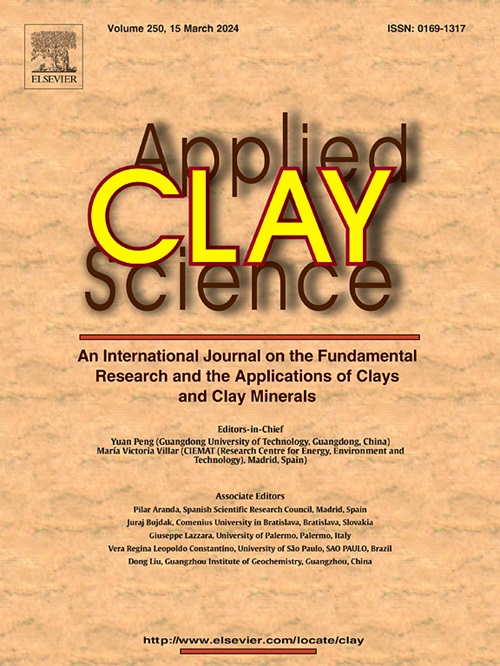Effect of on stereoisomers of lactic acids on microbially-mediated reductive dissolution of clay minerals: Insights from DFT and experimental studies
IF 5.3
2区 地球科学
Q2 CHEMISTRY, PHYSICAL
引用次数: 0
Abstract
Interactions between microorganisms and clay minerals occur ubiquitously in nature. It has been established that various factors can affect the interactions between microorganisms and clay minerals, such as temperature, pressure, pH, surface area and electron shuttle compounds. Lactic acid has two stereoisomer forms (L-(+)-lactic acid (L-(+)-lac) and D-(−)-lactic (D-(−)-lac)) and has widely been recognized as an important biomolecule that can be utilized as an electronic donor and/or carbon source by dissimilatory iron-reducing bacteria. Furthermore, lactic acid (endogenous or exogenous) has been shown to result in the dissolution of metal impurities from clay minerals. However, the synergistic effect of different lactic acid stereoisomers on abiotic processes (clay mineral dissolution) and biotic processes (microbial reduction) remains unclear, as well as the fundamental principles governing this process. To examine the differences between the effects of both stereoisomers of lactic acid on the interactions between microorganisms and clay minerals, experiments on microbially mobilized elements in clay mineral dissolution (MMED) were carried out in the presence of either L-(+)-lac or D-(−)-lac. Experimental results showed that the interdependence between coupled abiotic and biotic processes, created a synergy between these processes. Furthermore, to investigate the molecular or atomic level interactions, such as electrostatic charges and bond formation, that occur during the attachment of L-(+)-lac and D-(−)-lac onto mineral surfaces. Molecular dynamics (MD) simulations were used to distinguish between the adsorption pathways of L-(+)-lac and D-(−)-lac on clay minerals. The results of density functional theory (DFT) calculations indicated that the presence of lactic acid affected the electron distribution profile of clay mineral templates. The finding of this study provide insights into the role of lactic acid stereoisomers in promoting mineral-microbe interactrions.
乳酸立体异构体对微生物介导的粘土矿物还原溶解的影响:来自DFT和实验研究的见解
微生物与粘土矿物之间的相互作用在自然界中无处不在。研究表明,温度、压力、pH值、表面积、电子穿梭化合物等因素均可影响微生物与黏土矿物的相互作用。乳酸具有两种立体异构体形式(L-(+)-乳酸(L-(+)-lac)和D-(-)-乳酸(D-(-)-lac)),被广泛认为是一种重要的生物分子,可以被异化的铁还原细菌用作电子供体和/或碳源。此外,乳酸(内源性或外源性)已被证明会导致粘土矿物中金属杂质的溶解。然而,不同乳酸立体异构体对非生物过程(粘土矿物溶解)和生物过程(微生物还原)的协同作用以及控制这一过程的基本原理仍不清楚。为了研究乳酸的两种立体异构体对微生物与粘土矿物相互作用的影响差异,在L-(+)-lac或D-(−)-lac存在的情况下,对粘土矿物溶解(MMED)中的微生物动员元素进行了实验。实验结果表明,耦合的非生物和生物过程之间的相互依赖,创造了这些过程之间的协同作用。此外,研究分子或原子水平的相互作用,如静电电荷和键的形成,发生在L-(+)-lac和D-(−)-lac附着在矿物表面。采用分子动力学(MD)模拟方法对L-(+)-lac和D-(−)-lac在粘土矿物上的吸附途径进行了区分。密度泛函理论(DFT)计算结果表明,乳酸的存在影响了黏土矿物模板的电子分布。本研究的发现为乳酸立体异构体在促进矿物-微生物相互作用中的作用提供了见解。
本文章由计算机程序翻译,如有差异,请以英文原文为准。
求助全文
约1分钟内获得全文
求助全文
来源期刊

Applied Clay Science
地学-矿物学
CiteScore
10.30
自引率
10.70%
发文量
289
审稿时长
39 days
期刊介绍:
Applied Clay Science aims to be an international journal attracting high quality scientific papers on clays and clay minerals, including research papers, reviews, and technical notes. The journal covers typical subjects of Fundamental and Applied Clay Science such as:
• Synthesis and purification
• Structural, crystallographic and mineralogical properties of clays and clay minerals
• Thermal properties of clays and clay minerals
• Physico-chemical properties including i) surface and interface properties; ii) thermodynamic properties; iii) mechanical properties
• Interaction with water, with polar and apolar molecules
• Colloidal properties and rheology
• Adsorption, Intercalation, Ionic exchange
• Genesis and deposits of clay minerals
• Geology and geochemistry of clays
• Modification of clays and clay minerals properties by thermal and physical treatments
• Modification by chemical treatments with organic and inorganic molecules(organoclays, pillared clays)
• Modification by biological microorganisms. etc...
 求助内容:
求助内容: 应助结果提醒方式:
应助结果提醒方式:


